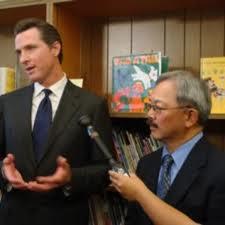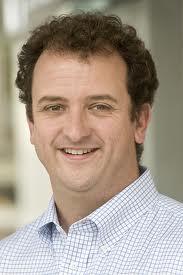Well, Sean didn’t stop by for tapas at Que Syrah last night, but he did take the time to send me a long letter answering my questions about why he “mysteriously” nominated CAO Ed Lee for interim mayor in Tuesday’s Board of Supervisors meeting.
I appreciate the letter and it’s to Sean’s credit that this is his modus operandi with the Guardian (and others) in answering questions, even pesky ones.
I am printing his letter in full below and offering him the opportunity to continue this illuminating conversation since his letter raises even more questions about his nomination of Lee.
For example, the Bay Citizen section of today’s New York Times, on the morning of the followup supervisors’ meeting this afternoon, laid out a detailed story by Gerry Shih of how former Mayor Willie Brown, Rose Pak, a powerful Chinatown political operative, and Mayor Newsom orchestrated the Lee nomination to keep the mayor’s office safe for PG&E, the downtown gang, and Willie/Pak’s clients and allies.
The headline: “Behind-the-Scenes Power Politics: The Making of a Mayor,” with pictures of Newsom, Willie, and Pak. The motivation for the orchestration, according to the story, was that on Sunday afternoon “Word had trickled out that the main contenders for the job were Sheriff Michael Hennessey, former Mayor Art Agnos and former board chairman Aaron Peskin” and the three were “deemed too liberal” by Pak, Brown and Newsom.
Then, the story said that over the next 48 hours, Pak, Brown and the Newsom administration “engaged in an extraordinary political power play, forging a consensus” on the board, “outflanking the board’s progressive wing” and persuading Lee at the last moment shortly before he boarded a plane to Taiwan to agree “to become San Francisco’s first Asian-American mayor, even though he had told officials for months that he had no interest in the job.”
The story noted that Pak was “in a boastful mood the next day, several hours before she planned to have celebratory drinks with Brown at the Chinese Hilton,” (Willie, last time I checked, was on an annual PG&E retainer of $200,000 plus.) The story ended with a telling quote from Pak: “Now you know why they say I play politics like a blood sport.”
So the new questions I have for Sean (and other supervisors who voted for Lee) is what did they know and when did they know it? Or were they even informed about the deal and how it came down? Is this the West Portal supervisor’s idea of how to choose a mayor?
P.S. Sean and his fellow Lee supporters may not think it’s important for the Guardian (or other media or citizens) to be able to ask questions of Lee or other candidates before making him mayor.
Well, I think it’s important and I have some basic questions: What is Lee’s position on rent control? On progressive taxation to help solve the crushing budget crisis? On rubberstamping Newsom/Pak/Brown policies as mayor? And on community choice aggregation and public power and kicking PG&E out of the mayor’s office? The last question on PG&E is critical, because this is the key litmus test in political San Francisco. Any politician, elected or appointed or emerging, who supports PG&E and opposes public power/CCA is not to be trusted. Did anybody get to ask Lee any of these questions or any others? Let’s lay out the questions and Lee’s answers before making him the reluctant mayor.
Here’s Elsbernds letter to me:
Bruce,
Good to hear from you. As always, I enjoy the conversation, particularly
with those District 7 constituents who so often and consistently advocate
positions contrary to the vast majority of residents in District 7 (e.g.
the Guardian’s endorsement against Proposition G, which received over 70%
of the vote in District 7), but every now and then, present a fresh
perspective worth analysis.
I believe Ed Lee will make an outstanding Interim Mayor. You asked me the
following questions to justify this. Let me give it my best shot.
Why did I nominate Ed Lee for Interim Mayor when he was out of town? His
presence was immaterial to me. I had the opportunity to discuss his
interest in the position with him prior to the vote, and I have worked with
him for nearly 10 years, and know where he stands on various positions. I
did not need him in the room on Tuesday evening to answer questions as I
had done my homework before showing up to class.
Why did I nominate Ed Lee when he was not publicly “out there” or “in
public discussion” as a candidate or even known by the Supervisors to be a
legitimate candidate? Whether or not Ed Lee’s name was known to you, your
readers, or other Supervisors, is not a fact to which I can speak. After
all, I do not fit any one of those 3 criteria. Ed was always a candidate
to me, and, most importantly, the qualities of an Interim Mayor were “in
public discussion.” These qualities, which I heard from residents in
district 7 and throughout the City, were that the individual be someone not
wanting to run for re-election, someone, who had a demonstrated ability to
appeal to all cross sections of the political spectrum, someone who knows
the City (both how it functions as a government as well as its many
neighborhoods), and, someone with demonstrated experience in a variety of
areas of public policy.
Why did I nominate Ed Lee when he has not publicly stated his views on any
of the major issues coming before the Mayor? Yes, it’s true he has not
filled out a Bay Guardian questionnaire, or been grilled by your editorial
Board. However, an astute observer of Ed’s career can decipher well his
positions. Moreover, Ed was most recently confirmed unanimously to serve
as CAO of the City and County, for the second time. During that
confirmation process, I had the opportunity, as did every other member of
the Board and the public to present issues to Ed for his analysis. The
tough issues facing the Mayor, are the same tough issues facing the CAO,
the Supervisors, and everyone else charged with the duty of serving the
public.
Why did I nominate Ed Lee when he was not available for questioning by the
Board when the discussion and vote came down? Yes, Ed was not present.
However, as I stated earlier, Ed had always been available to talk prior to
his departure. I was able to ask my questions before he left.
Why did I nominate Ed Lee when he is not as qualified for this tough post
in these tough times as the other public candidates? Well, this question
implies a bit of a comparison to the other candidates. I respect the other
candidates too much to say anything negative about them. Simply put, I
believe Ed is the lone candidate with the sufficient breadth, most
relevant, and most timely experience across City government, and the one
who had the greatest ability to bring all sides of the political spectrum
together.
Why did I nominate Ed Lee when he was obviously part of a backroom deal
orchestrated by Mayor Newsom and his downtown allies? I love questions
based on evidence and fact. This question, however, is merely a question
based on your opinion. I disagree with that opinion. Ed Lee was elected
Interim Mayor because he is the most qualified candidate.
Finally, thanks for the invitation to Que Syrah this evening.
Unfortunately, as a working parent, my weeknight evenings do not belong to
me – they belong to my son. I’ll be with him tonight. I hope you’re still
able to enjoy yourself without me.
All the best,
Sean
P.S. It’s the “Village Grill,” not the “Village Inn .” Perhaps you need
to get out on West Portal a bit more and learn the name of the
establishments along the street.


